Domestic anti-submarine bombers. Part I
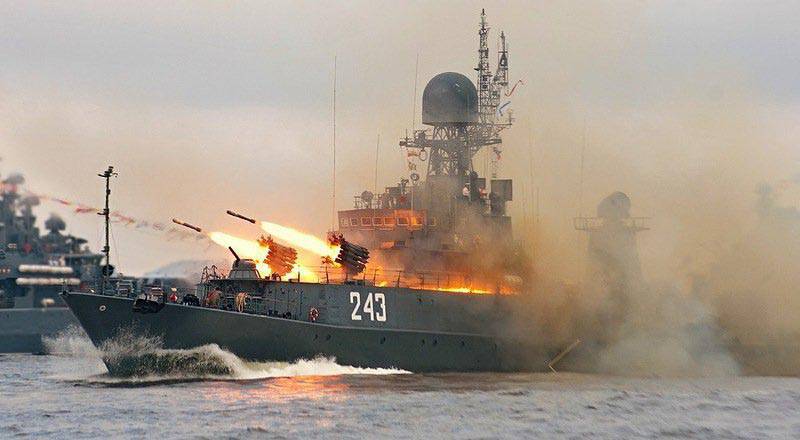
Depth charges quickly established themselves as a reliable means of fighting enemy submarines. However, on the effectiveness of this weapons affected the method of application, namely the discharge from the fodder bomb. It was necessary to correctly calculate the course of the ship or boat, so that the dropped bombs fell into the enemy's submarine. The complexity of a successful attack was more than offset by the power of the charge. Only one depth bomb with a charge of several tens of kilograms of explosive could seriously damage a submarine or even destroy it. Nevertheless, the mariners needed a means for quickly delivering the bomb to the enemy’s submarine without complicated maneuvers. Already at the end of the First World War, projects of the so-called began to appear. bomb bomb - weapons that use artillery principles to deliver bombs to targets.
BMB-1
In 1940, in service with the Soviet Navy, the BMB-1 bar bomber was adopted. This weapon was created in Leningrad SKB-4 under the direction of B.I. Shavyrina. SKB-4 was engaged in the development of artillery systems and applied the existing developments in the creation of a new bomb bomb. From the point of view of design and principle of operation, the BMB-1 hatch bombers were mortars for firing a caliber projectile.
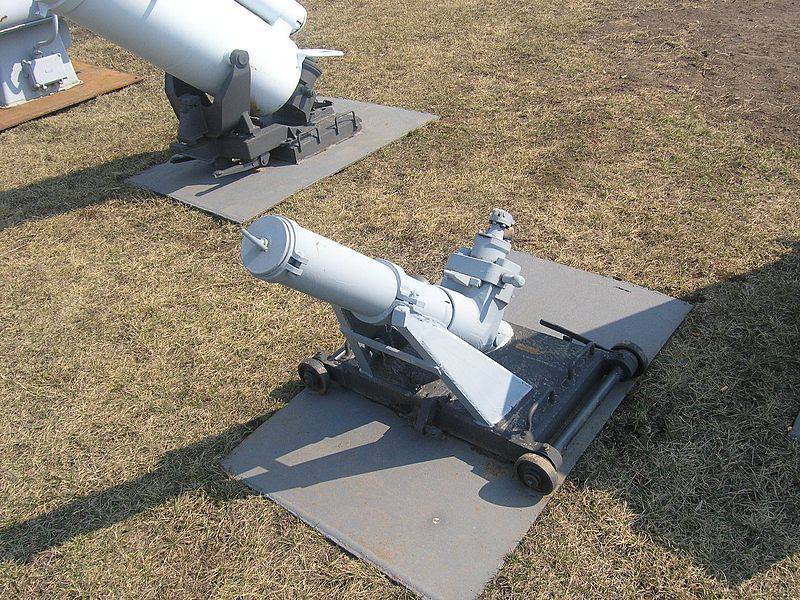
The base of the BMB-1 bomb was a base plate with two pairs of wheels for transportation. The trunk and its fastening system were installed on the stove. Vertical guidance was not provided: the trunk was rigidly fixed with an angle of elevation 45 °. In the breech there was a bolt with a propellant ignition system. For protection against water the barrel of the weapon was provided with a lid.
The main ammunition of the BMB-1 bomb was the depth bomb BB-1 arr. 1933 of the year, equipped with a special stock (hence the name "pin bombers"). Ammunition weighing 165 kg carried 135 kg of explosive. At speeds up to 2,5 m / s, the BB-1 bomb could descend to depths up to 100 meters. For use with the bomb, the bomb was equipped with a rod - a rod placed in the gun barrel. The use of the over-caliber scheme made it possible to ensure the firing of large ammunition while maintaining the acceptable size of the weapon.
As conceived by the designers, the BMB-1 bomb was supposed to shoot a depth bomb at one of the specified distances. By changing the propellant charge, you could shoot at 40, 80 or 110 meters. It was assumed that the crew of the carrier ship would be able to fire directly on the course or on the ship's beam, turning the bombers in the right direction.
The BBB-1 hatch bomb bombers were installed on ships of various types and used throughout World War II. The power of the BB-1 made it possible to inflict heavy damage on enemy submarines, but the relatively low rate of fire and the short range of fire limited the capabilities of the weapon. In addition, the use of the BMB-1 bomb bomb required special rods, complicating the supply and operation of weapons.
BMB-2
The operation of the BMB-1 hinge was rather complicated, which is why the designers under the guidance of B.I. Shavyrina in the next project abandoned the use of stocks. A new anti-submarine weapon of ships and boats was to be a single barrelless bomber BMB-2.
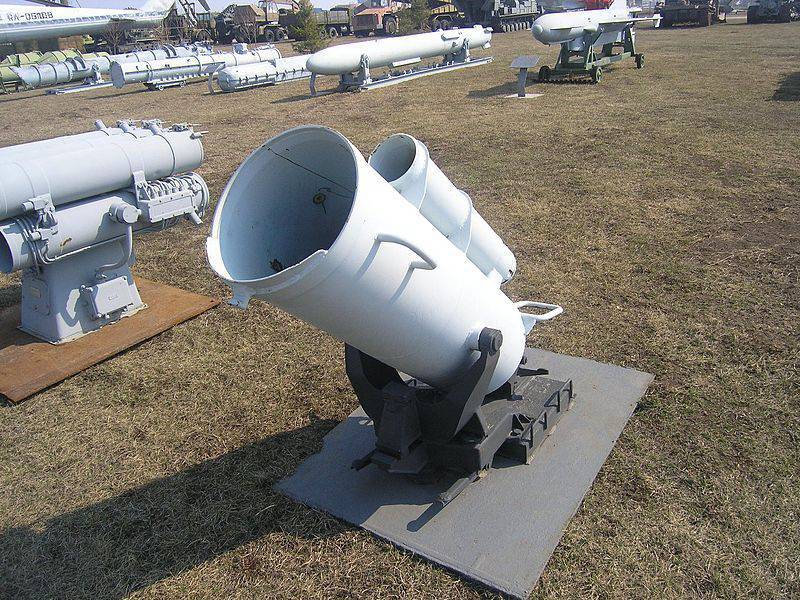
By design, the BMB-2 in some features was similar to the BMB-1, but it had a lot of differences. On the fixed support platform, the trunk installation system was attached. The weapon was supposed to fire with the existing depth charges without any additional devices, as a result of which a barrel of relatively short length 433 mm was obtained.
The design of the BMB-2 bomb bomb allowed you to fire on one of the calculated distances: 40, 80 or 110 meters. The impossibility of turning the gun led to the fact that the fire could be conducted only on the beam of the ship.
Initially, the main ammunition of the BMB-2 bomb was supposed to be made by the BB-1 depth bomb, the dimensions of which were taken into account when developing the barrel. At the end of the forties, a BPS depth bomb was created, distinguished from the BB-1 by a greater immersion speed. Bomb weighing 138 kg carried 96 kg of explosive. The bomb case had a streamlined shape and was equipped with stabilizers. The new form of the hull allowed the BPS bomb to sink at speeds up to 4,2 m / s.
The BMB-2 bomb was adopted in 1951 year. The rodless system made it possible to simplify the operation of weapons in comparison with the previous bomb. However, the characteristics of the new instrument were already insufficient. By the beginning of the fifties, the characteristics of submarines and their torpedoes had significantly increased and often exceeded the capabilities of the new Soviet bomb bomb. In connection with this, the BMB-2 bombometer rather quickly gave way to new systems with higher characteristics.
MBU-200
Depth bombs of the BB-1 and BPS were quite effective weapons, but their use as ammunition for the BMB-1 and BMB-2 bombers had serious problems. Home - low rate of fire, due to which the probability of hitting an enemy submarine was at an unacceptable level. The solution to this problem could be the creation of a multi-barreled system, sending several bombs to the target simultaneously. Such weapons already existed abroad and were used by Soviet sailors. During the years of the Great Patriotic War, the British delivered several dozen Mk 10 Hedgehog bombers to the Soviet Union. Despite a number of existing problems, this system made it possible to literally sow a plot of several hundred square meters with depth charges. In KB under the leadership of B.I. Shavyrina decided to use British ideas and create their own weapons based on them - the bomb-gun MBU-200. This weapon was the first domestic bomber, whose name showed the maximum firing range: "200" meant 200 meters.
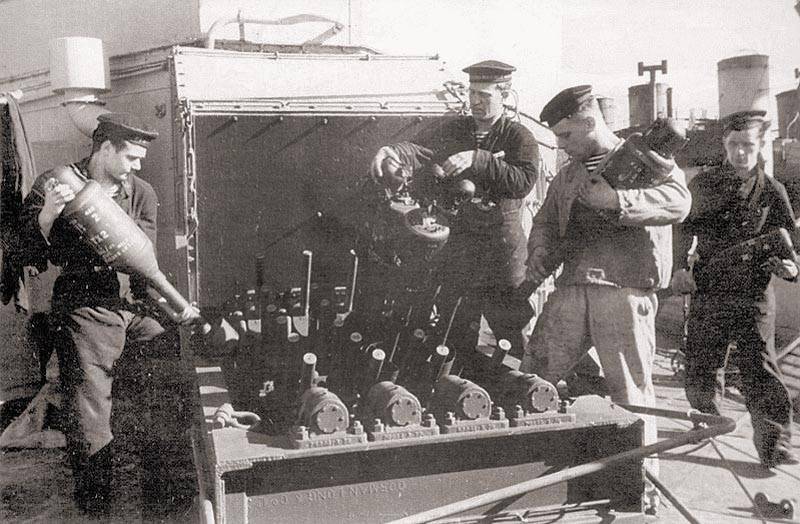
The main element of the new antisubmarine bombard MBU-200 was a roll-stabilized platform with mounts for the remaining nodes. In the rear part of it there was a gas shield that protected the ship's design from powder gases. On the platform, there were 24 inclined guides (four longitudinal rows of six each) with a vertical guidance system. The calculation of the bombet could change the elevation angle of each of the 24 guides independently of each other. In this way, it was possible to change the dimensions of the fired area. The bomb was equipped with an electrical propellant ignition system. Shooting was conducted using the device PUSB-24-200. The bomb operator was to receive target designation from the sonar.
Especially for the bomb-bomb MBU-200 in the Scientific Research Institute-24 of the Ministry of Agricultural Engineering, a new depth bomb B-30 was developed. The ammunition had a body consisting of two mated cylinders of different diameters, as well as a tailpipe, worn on the guide. The B-30 bomb carried a kg of explosive 13 and was equipped with a percussion fuse.
In preparation for the shot, the calculation of the bombet was to install guides to the desired angle of elevation. Further, the tail tube bombs were put on guides. The MBU-200 bomber was installed permanently on the bow of the carrier ship, due to which horizontal guidance was to be carried out using maneuvering. The maximum firing range reached 180-200 meters. Due to the individual inclination of each guide and a small "collapse" of the extreme guides to the sides, the bomb-gun MBU-200 could cover the ellipsoid area with dimensions 45-50 m wide and 35-40 m in the direction of firing. 24 volley bombs increased the chance of hitting and destroying a target.
The wide use of ideas borrowed from the British bomb-bomb allowed the Soviet designers to complete all the works fairly quickly. Anti-submarine bombers MBU-200 was adopted in 1949 year. This weapon was installed on ships of various types. The most massive of its carriers were the guard ships of the 50 "Ermine" project, built with a series of 68 units. Each of these sentrymen carried one bomb-gun MBU-200, intended for firing at targets in front of the nose, and four BMB-2 for firing at the traverse of the ship.
MBU-600
In 1955, an upgraded version of the MBU-200 bomb bomb and a new ammunition for it appeared. The MBU-600 bomber launcher retained the basic features of the base weapon: the roll-stabilized platform and the 24 inclined guides. However, to improve performance, some innovations were applied.
Sam bombed finalized based on operating experience MBU-200. In addition, some changes were made in connection with the use of new bombs with a more powerful propellant charge. To control the shooting, a PSB-24-600 device was created.
The upgraded B-30M bomb had a smaller diameter case in comparison with the base version. To improve the aerodynamic characteristics of the new depth bomb had an elongated streamlined body, as well as an elongated conical tail pipe casing. In the tail of the munition there was a stabilizer. The change in the design of the bomb made it possible to increase the explosive charge to 14,4 kg. For blasting the warhead answered contact fuse.
The operating principle of the MBU-600 bomb bomb was the same as that of the MBU-200. From the point of view of operation, the new bomber differed from the old one only in the firing range and area of the area being shot. The maximum range of the B-30М depth bombs was 640 m. The ammunition of one volley fit into an ellipse 80х45 m. The MBU-600 bomb was much more efficient than its predecessor, as it allowed the enemy's submarines to attack three times as far.
The development and testing of the MBU-600 system ended in the 1955 year. In 56, these weapons were adopted. The MBU-600 bomb was used on the 264 project head minesweeper (serial ships of this type received a different type of anti-submarine system), as well as on various destroyers and patrol ships.
RBU
The MBU-600 bomb was the last domestic system of this class that used the "traditional" method of firing ammunition. Further development of anti-submarine bombers proceeded along the path of creating jet systems. The use of rocket projectiles made it possible to significantly increase the effectiveness of bomb bombers without resorting to the complexity of the design of weapons or ammunition.
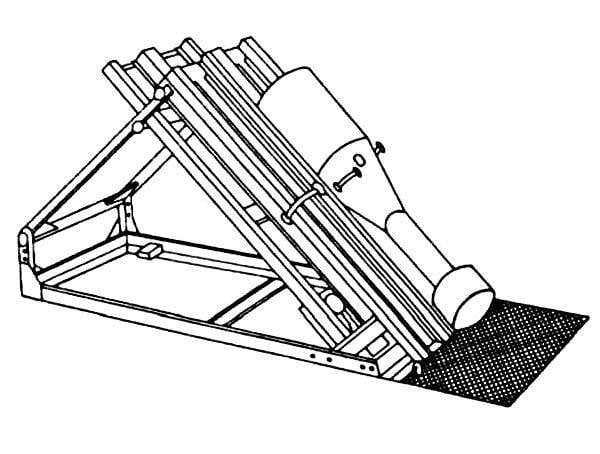
The first Russian rocket launcher jet-bombers were created in 1945 year. The authors of the project are V.A. Artemyev and S.F. Fonarev, who worked under the leadership of Major-General S.Ya. Bodrova. Soviet engineers knew about the American antisubmarine system Mousetrap and created their project "with an eye on" foreign experience. Such borrowing of ideas allowed to achieve sufficiently high performance. The RBU system was not inferior in its characteristics to the BMB-1 hatch bomber, and in some cases surpassed it.
The RBU jet bomber itself had an extremely simple design. Rail guides for four missiles (two rows of two guides) were rigidly attached to the main frame. The elevation angle was fixed and was 15 °. It was proposed to install two jet bombets each in the bow of the carrier ship: at the same time, eight depth charges could be sent to the target.
For use with the RBU bombometer, a depth bomb was developed with a RBM jet engine. This ammunition was a bomb BM-1, equipped with a tail block with a jet engine and stabilizer. The RBM bomb carried an 25 kg of explosive and could sink at a speed of about 3,2 m / s. The rocket bomb was equipped with a K-3 hydrostatic fuse, designed for use at depths up to 210 meters.
The RBU bombardment could be induced in the horizontal plane only by turning the entire ship. The constant angle of elevation of the guides ensured firing only at a fixed range. Using the BSR bombs, the calculation of the bomb bomb could shoot at a distance of 240-250 meters and cover the site with dimensions of 40х85 m. Despite the smaller charge, the RBM bombs due to their number could become a much more effective weapon than BMB-1 bomber ammunition.
The RBU jet bomb and the BSR depth bomb were adopted in 1945 year. The relatively small size and lack of feedback allowed using this system on ships and boats of several types. RBU bombers were used at least until the mid-fifties, after which they were replaced by new systems of this class.
RBU-1200 "Hurricane"
With its simplicity of design, the RBU jet bombometer proved to be a reliable and convenient weapon. For this reason, work on the subject of anti-submarine jet bombs was continued. At the beginning of the fifties, employees of the Scientific Research Institute-1 (now the Moscow Institute of Thermal Engineering) under the direction of S.Ya. Bodrova and V.A. Artemyeva worked on the RBU-1200 bombing project, which was to be part of the Uragan anti-submarine system.
Bombet RBU-1200 was a launcher for missiles, equipped with a vertical pickup system. Rotation of the installation in the horizontal plane was not envisaged. There was a stabilization of rolling. A block of five barrels of 253 mm caliber was located on the turntable of the bombet. Bomb-bomb drives allowed to direct trunks vertically in the range from 0 ° to + 51 °.
In the first half of the fifties, a new rocket depth bomb RSL-1200 was developed for the bombers of RBU-12 and RBU. The ammunition weighing 73 kg carried 32 kg of explosive and was equipped with a K-3 hydrostatic fuse. Later, the RSL-12 bombs began to be completed with a KDV contact-distance fuse, which provided for undermining the charge both at a predetermined depth and in a collision with a target. The speed of a new bomb reached 8 m / s.
Using the RGB-12 jet bombs, the calculation of the bomb-bomb RBU-1200 could attack targets at ranges of 400-1400 meters. The maximum depth of damage to the target was limited by the capabilities of the fuses and was 300-330 m. A volley of five bombs was scattered over the elliptical 70 x120 m. The volley took no more than 2 seconds.
An important feature of the “Uragan” complex, which included the RBU-1200 bombing bomb, was the control system of the same name, “Uragan”. The system automatically received information about the target (range, depth, course and speed) from the sonar complex and could independently calculate the time of launch of bombs. The new control system "Hurricane" allowed to significantly improve the accuracy of shooting.
It should be noted that the RBU-1200 jet-bomber had a number of serious flaws, including in comparison with previous domestic anti-submarine systems. So, in the course of a single salvo, he could send only 5 depth charges to the target, for horizontal laying it was necessary to maneuver the ship, and reloading was done manually. Nevertheless, the long range and accuracy of fire, as well as the presence of several bomb-bombs on one ship, compensated for all the shortcomings.
The RBU-1200 bomb launcher was put into service in 1955 and was installed on several types of ships: small anti-submarine projects 122, 122-bis 12412, minesweepers of Project 266M and border boats of Project 12412P. Bombombets, both separately and as part of the armament of ships, were transmitted fleets several foreign countries. On the basis of the RBU-1200 system, Chinese engineers created several of their own bombers with various characteristics. In addition, the Soviet rocket launcher became the basis for the Type 81 Chinese remote clearance vehicle, equipped with a 10-barrel launcher.
RBU-2500 Smerch
The main drawbacks of the RBU-1200 jet bomb were the insufficient number of bombs in the salvo and the impossibility of horizontal guidance. When developing the new anti-submarine system RBU-2500, the drawbacks of the existing weapons were taken into account. The Smerch system with a RBU-2500 jet-bomber was created at SRI-1 under the direction of N.P. Mazurov.
All units of the new bomb-bomb were fastened on the supporting platform and the rotary base. Unlike the previous systems, the RBU-2500 bombometer could rotate around its axis and direct the stems in a horizontal plane. The new bombayer received 16 trunks (two horizontal rows of eight trunks) caliber 212 mm. With the help of hydraulic actuators, the barrels of RBU-2500 could be induced in any direction in the horizontal plane (with the exception of the directions blocked by the ship's structure). The maximum elevation angle reached 50 °.
The main ammunition bombardment RBU-2500 was the depth bomb RSL-25. This ammunition with a total length of 1350 mm and a weight of 84 kg carried a charge of explosive 25,8 kg and could sink at speeds up to 11 m / s. The hydrostatic fuse allowed the depth of the blast to be set to 350 m. The new jet engine delivered the bomb at a distance to 2500 m from the ship. The minimum shooting range was limited to 500 meters. By the beginning of the sixties, a non-contact acoustic fuse WB-1M with a radius of action 6 was adopted. The non-contact fuse was used together with the standard hydrostatic one. To indicate the detected targets, a “Candle” landmark bomb with the weight and dimensions of the combat RSL-25 could be used.
To control the RBU-2500 bombshell, the Smerch SSDR system was used, supplemented with the sound prefix. The algorithm of the new weapons remained the same as in the case of the previous RBU-1200. In its capabilities, the new jet bombs surpassed the previous one, due to a significant increase in ammunition and the possibility of horizontal aiming. It should be noted that the RBU-2500 system retained manual recharging, however, a greater number of barrels and the use of several bomb-bombs on one ship compensated for this shortcoming.
The RBU-2500 jet-bombshell was put into service in the 1957 year. This system was installed on destroyers of 31, 41, 56, 56-PLO, 56-М, 56-ЭМ and 56-А projects, as well as on the watchdog of 50-PLO ave. In addition, the Smerch anti-submarine system was supplied to some foreign countries: Vietnam, India, Romania and Syria.
Based on:
http://flot.sevastopol.info/
http://vadimvswar.narod.ru/
http://otvaga2004.ru/
http://wunderwafe.ru/
http://ship.bsu.by/
http://rbase.new-factoria.ru/
http://militaryrussia.ru/blog/topic-128.html
Shirokorad A.B. Weapons of the domestic fleet. 1945-2000. - Minsk: “Harvest”, 2001
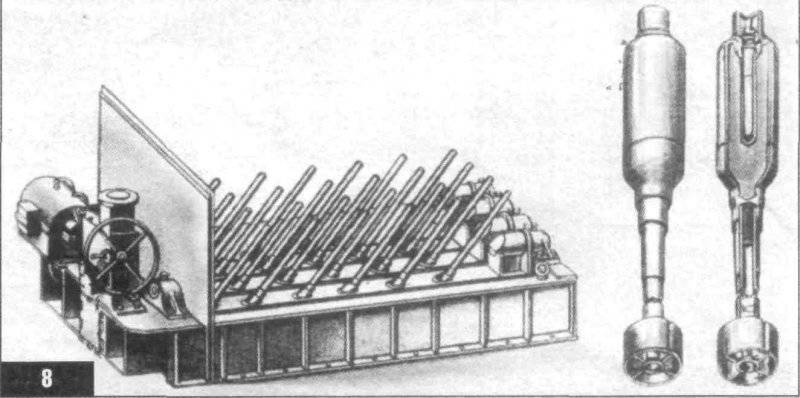
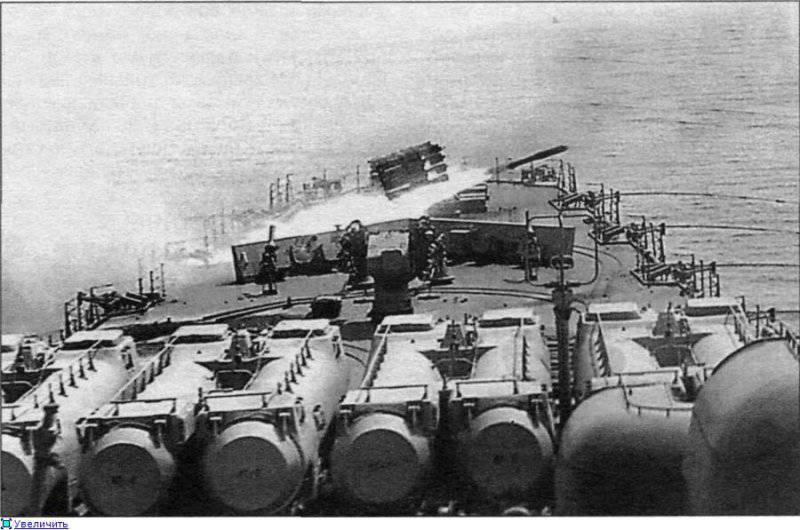
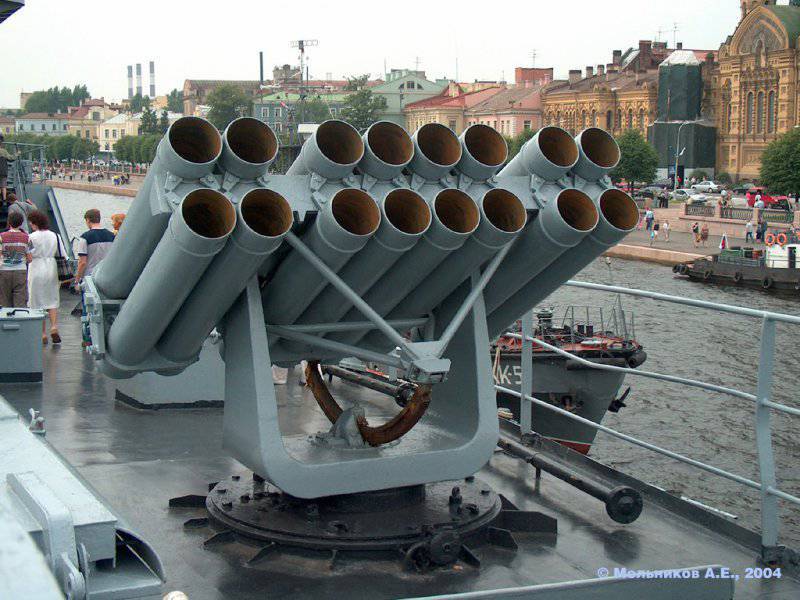
Information